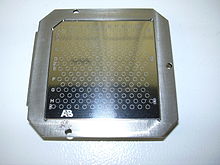Peptide bulk fingerprint

A peptide mass fingerprint (PMF) (English protein fingerprinting ) is an analytical technique in biochemistry for the identification of proteins by SDS-PAGE , protease digestion and mass spectrometry . The peptide mass fingerprint was developed independently by several groups in 1993.
principle
In this process, an as yet unknown protein is first digested , usually with the protease trypsin via an in-gel digestion , into smaller peptides , the absolute masses of which are measured very precisely with a mass spectrometer such as a MALDI-TOF or an ESI-MS can. These measured masses are then compared either with those of a database such as Mascot for known protein sequences or with those of a genome database . This is made possible by the use of computer programs that translate the known genomes of the organisms into proteins, then theoretically ( in silico ) cut these proteins into peptides and then calculate the absolute masses of the peptides. Finally, the measured masses of the peptides of the unknown protein are compared with the theoretical peptide masses and the results are statistically evaluated in order to find the best agreement.
The advantage of this method is that only the masses of the peptides need to be known. Time-consuming protein sequencing of the peptides is then not necessary. The disadvantage is that the protein sequence you are looking for has to be found in a database such as Mascot . In addition, most peptide bulk fingerprinting algorithms assume that the peptides come from a single protein. If a mixture of proteins occurs, the analysis becomes considerably more difficult and can possibly lead to incorrect results.
Prior protein purification is important for the identification of proteins by a peptide mass fingerprint . Mixtures of more than two to three proteins require additional use of MS / MS-based techniques for identifying proteins in order to achieve sufficient specificity of the identification. Therefore, suitable samples for peptide mass fingerprints are protein spots cut from 2D gels or individual SDS-PAGE bands after in-gel digestion.
Alternatives to the peptide mass fingerprint are e.g. B. Edman degradation or a molecular display with subsequent DNA sequencing .
swell
- ↑ Pappin DJ, Hojrup P, Bleasby AJ: Rapid identification of proteins by peptide-mass fingerprinting . In: Curr. Biol . 3, No. 6, 1993, pp. 327-32. doi : 10.1016 / 0960-9822 (93) 90195-T . PMID 15335725 .
- ↑ Henzel WJ, Billeci TM, Stults JT, Wong SC, Grimley C, Watanabe C: Identifying proteins from two-dimensional gels by molecular mass searching of peptide fragments in protein sequence databases . In: Proc. Natl. Acad. Sci. USA . 90, No. 11, 1993, pp. 5011-5. bibcode : 1993PNAS ... 90.5011H . doi : 10.1073 / pnas.90.11.5011 . PMID 8506346 . PMC 46643 (free full text).
- ↑ Mann M, Højrup P, Roepstorff P: Use of mass spectrometric molecular weight information to identify proteins in sequence databases . In: Biol. Mass Spectrom. . 22, No. 6, 1993, pp. 338-45. doi : 10.1002 / bms.1200220605 . PMID 8329463 .
- ↑ James P, Quadroni M, Carafoli E, Gonnet G: Protein identification by mass profile fingerprinting . In: Biochem. Biophys. Res. Commun. . 195, No. 1, 1993, pp. 58-64. doi : 10.1006 / bbrc.1993.2009 . PMID 8363627 .
- ↑ Yates JR, Speicher S, Griffin PR, Hunkapiller T: Peptide mass maps: a highly informative approach to protein identification . In: Anal. Biochem. . 214, No. 2, 1993, pp. 397-408. doi : 10.1006 / abio.1993.1514 . PMID 8109726 .
- ↑ Clauser KR, Baker P, Burlingame AL: Role of accurate mass measurement (+/- 10 ppm) in protein identification strategies employing MS or MS / MS and database searching . In: Anal. Chem. . 71, No. 14, 1999, pp. 2871-82. doi : 10.1021 / ac9810516 . PMID 10424174 .
- ↑ a b Shevchenko A, Jensen ON, Podtelejnikov AV, Sagliocco F, Wilm M, Vorm O, Mortensen P, Shevchenko A, Boucherie H, Mann M: Linking genome and proteome by mass spectrometry: large-scale identification of yeast proteins from two dimensional gels . In: Proc. Natl. Acad. Sci. USA . 93, No. 25, 1996, pp. 14440-5. bibcode : 1996PNAS ... 9314440S . doi : 10.1073 / pnas.93.25.14440 . PMID 8962070 . PMC 26151 (free full text).
- ↑ Wang W, Sun J, Nimtz M, Deckwer WD, Zeng AP: Protein identification from two-dimensional gel electrophoresis analysis of Klebsiella pneumoniae by combined use of mass spectrometry data and raw genome sequences . In: Proteome Science . 1, No. 1, 2003, p. 6. doi : 10.1186 / 1477-5956-1-6 . PMID 14653859 . PMC 317362 (free full text).
- ^ Hufnagel P, Rabus R: Mass spectrometric identification of proteins in complex post-genomic projects. Soluble proteins of the metabolically versatile, denitrifying 'Aromatoleum' sp. strain EbN1 . In: J. Mol. Microbiol. Biotechnol. . 11, No. 1-2, 2006, pp. 53-81. doi : 10.1159 / 000092819 . PMID 16825790 .